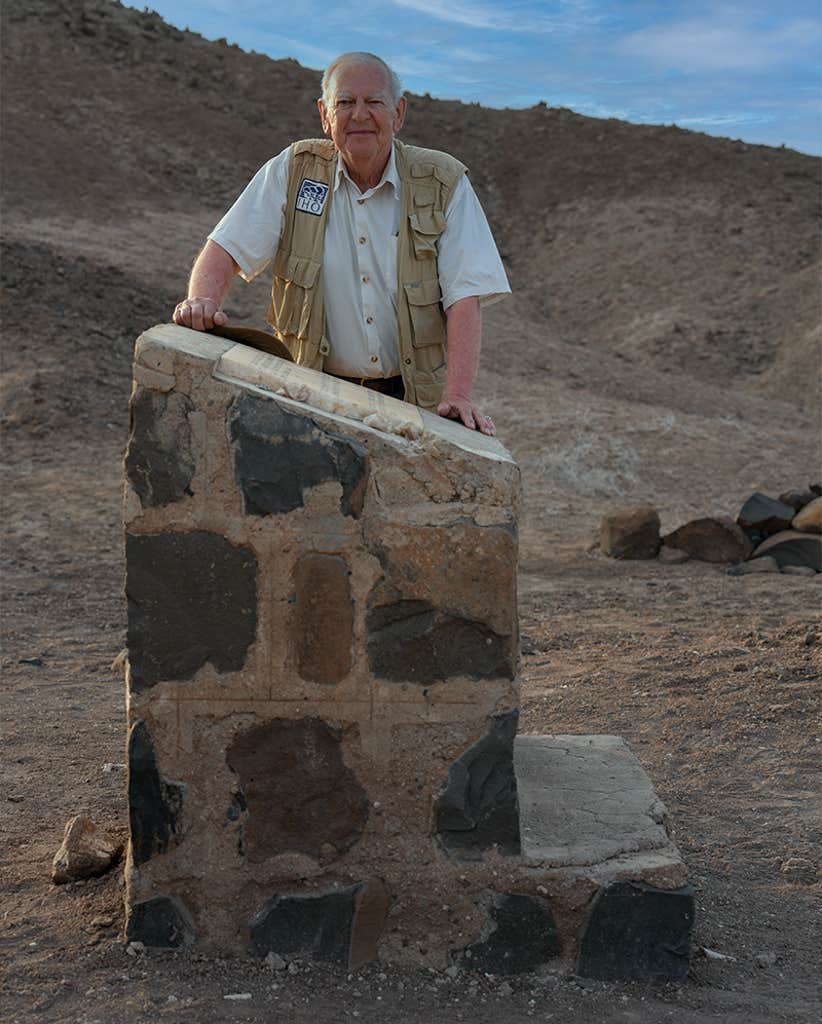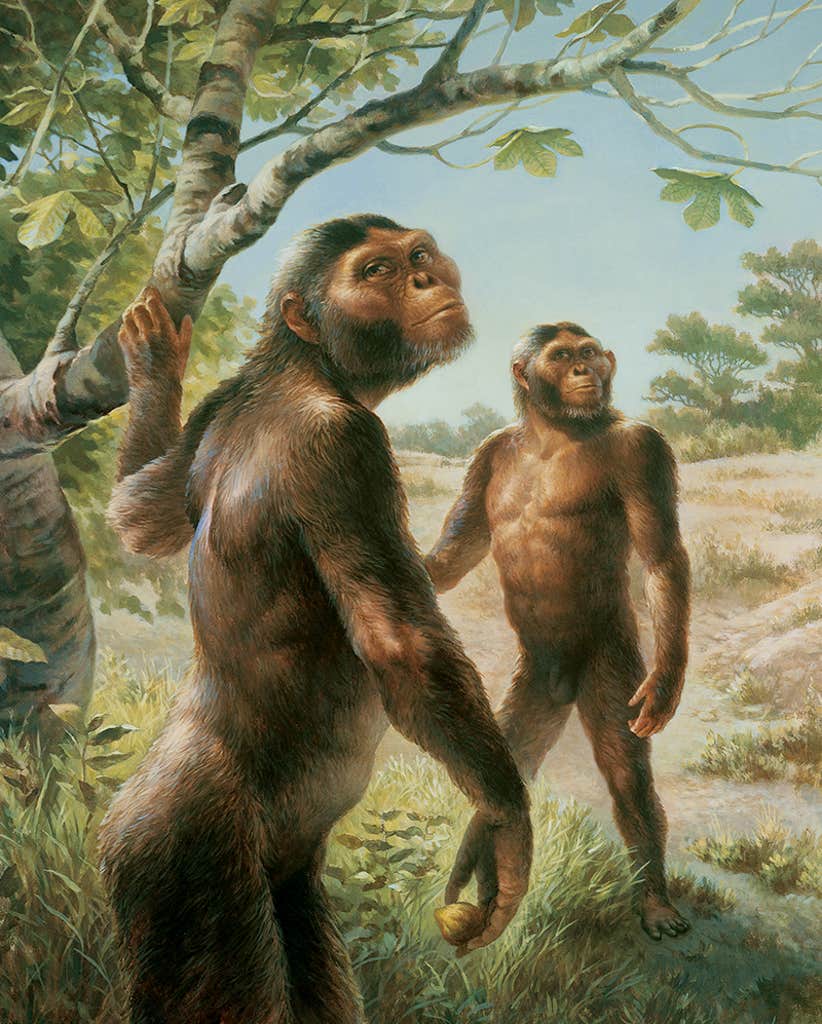Donald Johanson was 31 in 1974 when he came upon a set of bones belonging to an extinct hominin species at the Hadar fossil site in northeastern Ethiopia. Johanson, a newly minted Ph.D., was an associate professor of anthropology at Case Western University. The specimen that he found, about 40 percent complete and dated to 3.2 million years ago, was dubbed “Lucy” after the Beatles song “Lucy in the Sky with Diamonds.” Johanson and his team had been listening to Sgt. Pepper’s Lonely Hearts Club Band on their portable cassette player.
The species to which the skeleton belonged was given the name Australopithecus afarensis. “Australopithecus” means “southern ape” and “afarensis” refers to the Afar rift valley where the Hadar site is located. Today, 50 years later, more than 300 fossils of Australopithecus afarensis have been identified.
Lucy made ripples in the world of paleoanthropology right away. She had a small brain, not much larger than a chimpanzee’s, but walked upright, suggesting that an upright posture, rather than an increase in brain size, was the first step toward becoming human. The discovery “re-draws the human family tree,” as Johanson has put it, noting that Lucy’s descendants may include not only our own genus, Homo, but also other human groups that have died off.
The discovery also cemented the “out of Africa” picture of human evolution; there is no longer any question that this was where humanity got its start. (Along with afarensis, other related species include Paranthropus boisei, which lived in eastern Africa, and Australopithecus africanus and Paranthropus robustus, which lived in southern Africa.) As Denise Su, a colleague of Johanson, has said, Lucy “is still the reference point for understanding the anatomy of early human ancestors and the evolution of our own bodies.”
A half century after Johanson’s big discovery, he half-jokingly divides his life into “BL” (before Lucy) and “AL” (after Lucy). Before Lucy, teaching and field work in Africa, with long hours in the laboratory analyzing his findings, filled his days. After Lucy, he established the Institute of Human Origins in Berkeley, California; the Institute moved to Arizona State University in 1997, where it’s now recognized as one of the preeminent research organizations devoted to the science of human origins.
I recently caught up with Johanson over video to discuss the day of his famous discovery, what made Lucy unique, why Homo sapiens was left standing, and what might spell our extinction.

How vividly do you remember that day, November 24, in 1974?
I have very strong memories of that Sunday morning, when I was out with my then-graduate student, Tom Gray. It was a sort of a classic Hadar day—very few clouds in the sky, very hot of course. I was a little bit reluctant to go out that morning, because I had visitors in camp the previous two days and wanted to catch up on all the cataloging and other tasks we do in the field.
A fairly complete fossilized skull of a pig had been found at that site the year before, but it had never been exactly pinpointed on our maps, which is something that we regularly do, so we had to go out and do that. And there was a pile of stones as a marker for the exact spot where it was discovered. It was a place you had to climb up to; it was a fairly steep climb up a slope to a little plateau area. And when you’re out in an area like that, that I had not visited before, you might as well do a little survey.
We looked around and scanned the area and found fragments of baboons and fragments of antelope. It was about noon and getting pretty toasty. But I kept looking as we were walking along and glanced over my right shoulder at a little bone that I knew, even from standing height, was the ulna—this bone right here [points to his right forearm]. I could see that it wasn’t from a monkey, it wasn’t from an antelope. It was very tiny, but I could see that it bore all the diagnostic features of being from a hominin skeleton.
As we glanced around, we saw pieces of a skull, a chunk of jaw, some rib fragments. I said, “This could be part of the skeleton.” We knew it was more than 3 million years old because of the geological strata. We didn’t know exactly what it was, but I knew at that moment that this was going to be something extremely important.
How “human” was Lucy?
I sometimes refer to her as the ape that stood up. Let’s say we’re out shopping for groceries, we’re in the parking lot, and we see this strange-looking creature walking around. We would see that she was walking on two legs, and we would think that this is some kind of strange human. And as it got closer, one would see that it had a very projecting face, like an ape. It had a low sloping forehead and, relatively speaking, it had a very small cranium that obviously reflected a small brain. Aside from the fact that she walked upright, she was still remarkably ape-like.

Lucy’s genus, Australopithecus, flourished for a bit less than 1 million years, and then disappeared from the fossil record. Should we think of the Australopithecines as having “gone extinct”—or is it better to think of them as early members of a lineage that’s still thriving in the form of Homo sapiens?
Lucy’s species was successful over a long period of time. She could very possibly be the last common ancestor on the human family tree, of both the lineage that led to Homo, our own genus, and to other, later Australopithecus species. For our own genus, Homo, the earliest example we have is 2.8 million years old. That’s 200,000 years after Afarensis, Lucy’s species, vanishes. And what’s fascinating about early Homo specimens is that the anterior portion of the jaw looks like Lucy’s; it slopes back very strongly, it’s very heavily strengthened or buttressed with internal bone. And if you had just that frontal part, you might call it afarensis. So that supports the hypothesis that afarensis was an ancestor to Homo, which ultimately went through evolutionary change over time and led to species like Homo habilis, Homo ergaster, Homo erectus, the Neanderthals, and Homo sapiens.
We’ve come to see that the human family tree has more branches than we had previously thought. What does this multiplicity of branches tell us?
It tells us, essentially, that natural selection is very inventive; that there’s an opportunity to adapt to different diets, different environments.
But here’s a crucial question: At Hadar, there’s only Australopithecus afarensis. But you look elsewhere in the Great Rift Valley, or even in these cave sites in South Africa, and there are usually several species of humans running around—like “Nutcracker man” [Paranthropus boisei] and Homo habilis, and probably other early species of Homo. Why is there only one species at Hadar, but more at other sites? We don’t know.
As we glanced around, we saw pieces of a skull, a chunk of jaw, some rib fragments.
The working hypothesis is that there was probably greater diversity in terms of environmental niches, and that these different species of hominins were occupying different ecological areas. We never find Afarensis in southern Africa, we never find Africanus in eastern Africa. We never find Robustus in eastern Africa. We never find Boisei in South Africa. It means that these were two different evolutionary arenas where evolution was going on, probably fairly independently, under the guise of natural selection. They were very different species. The ones in eastern Africa are probably the ones that led to our own genus, Homo, and the ones in southern Africa, some people are suggesting, were successful in their own right, and lived in very different ecological environments, until they died out.
Today there’s just one hominin species left—us. What does that tell us?
We are a species that is now occupying a niche, a species that’s endlessly inventive. We have culture, and culture allows us, unfortunately, to dominate the natural world. And from what we can see, wherever humans—Homo sapiens—went, one of its worst behavioral features is that they don’t like the “other.”
Shortly after they got into Asia, Homo erectus—Peking Man and Java Man—disappeared. Shortly after they got into Indonesia, the “hobbits,” or Homo floresiensis, vanished. Shortly after they got into Europe, Neanderthals, who had been living there for hundreds of thousands of years, disappeared. So we are probably a highly destructive species, unfortunately, on the one hand; but on the other hand, we’re a boundless source of innovation and invention. So I think that we’re alone today as a single species because of our reliance on culture for survival.

What’s the biggest unanswered question about human origins?
Why was there so much change over a relatively short period of time? We’re looking at a planet that’s four-and-a-half billion years old, and we evolved into modern humans over a relatively short period of time, only about 7 million years—that’s one of the things that we are always trying to understand. What is the best model to explain our survival?
I think that there are hints. First, we’re the most cooperative species on the planet. If a chimpanzee wanders into another chimpanzee’s territory, they’re killed and eaten. Here we are [referring to our interview], we’ve never met, we don’t know each other, but we’re cooperating with one another. No other species has this level of cooperation. Second, within the cultural framework, no other animal has the inventiveness of what we sometimes call “cumulative culture.” Just in my lifetime—I banged out my doctoral thesis on a typewriter; before that, someone probably wrote theirs by hand.
Cumulative culture builds on what came before. Once you’ve got electricity, look what happened. Look what happened once the transistor was developed. And the third thing, of course, is what we’re doing right now, which is using symbolic language. And yes, it’s very likely that Neanderthals communicated with one another; they might have scratched some things on the walls—but they weren’t creating polychrome paintings 40,000 years ago inside caves in Europe, depicting the animals that lived around them, like at Chauvet and Lascaux. And I think that wherever we went, we dominated—and today we are a single species that dominates the planet.
Does the study of extinct hominins offer insight into the future of our own species?
The vast majority of all species that have existed on this planet have gone extinct. Why should humans be any different? It’s important to remember that we are not “super-organic,” as some people have talked about. No matter how sophisticated we are, we are still part of the natural world. We should celebrate the fact that Mother Nature was our creator, and we had better make the proper decisions so that we ourselves don’t go extinct. There are now 8 billion people in the world. Our ancestors had free food, they had free clean air, they had free clear water, they had free land—and now today, all of that’s changed dramatically. And I think that looking at the past should remind us that we are undoubtedly a species in peril, that we are slowly destroying the natural world that created us—and after that, what are we going to do? ![]()
Lead illustration by Michael Hagelberg
































